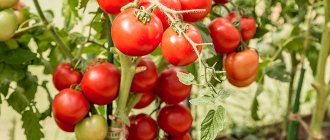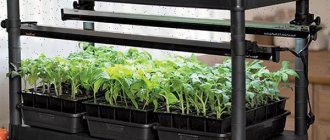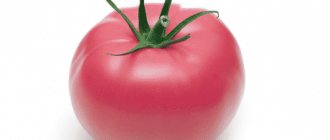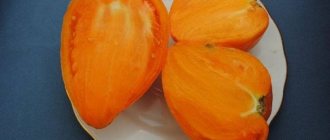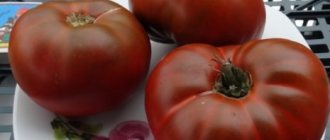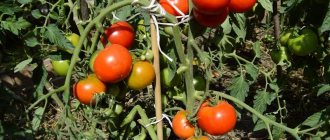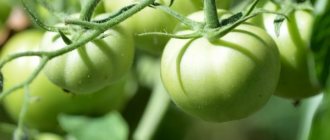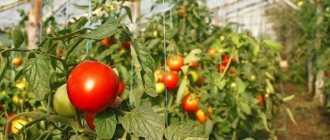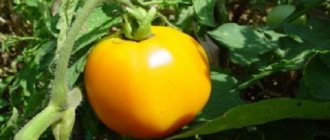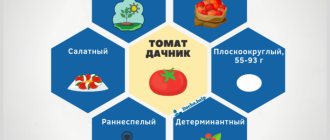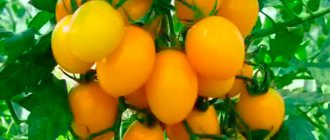With the Lord tomato, everything is very simple - simple cultivation, large yields, classic sizes and creamy shape. The variety is intended primarily for cultivation in the West Siberian region. But it is successfully cultivated in any other areas.
| Height | Landing location | Ripening time | Fruit color | Fruit size | Origin | Fruit shape |
| short | Greenhouse, Open ground | Mid-season | Reds | Average | Variety | Plum-shaped or oval |
Main characteristics
The hybrid is characterized by balance.
It is distinguished by the high growth of bushes and an increased ability to form the ovaries of future fruits even under not very favorable weather conditions. You can expect optimal yield when forming bushes with 1 stem. The remaining side shoots are subject to careful pinching. As for the fruits, they have a flat-round shape with slight ribbing, a rich red color at the stage of full biological maturity and an average weight of about 180 - 250 g. The density of the peel reliably prevents possible cracking of the fruit both during ripening and after heat treatment.
The fruits have good shelf life and can easily withstand long-term transportation, which makes them possible to grow for further sale. The use of fruits is quite universal, since they are suitable both fresh and for further processing.
The best varieties of tomatoes for open ground from collectors
There are a great many varieties of tomatoes in nature. What we see in markets and in vegetable departments of stores is only a small part of the entire variety of varieties. Therefore, when you set out to grow this crop yourself, you will be faced with the problem of choosing varieties and species, and the main selection criteria will be taste, aroma, transportation, the possibility of canning, quality and ease of care.
It will not be easy to choose one variety, because some crops grow an average harvest, available in stores and markets, but with better taste and quality characteristics. Other tomato crops are designed for greenhouse conditions.
Tomato plants are divided into 3 main types: indeterminate (tall), determinate (short) and dwarf (for hanging baskets). Each species has its own characteristics and requirements for planting, care, growth conditions and ovary formation.
Indeterminate species - tall plants that need support and tying. When tying the bushes, the side shoots are removed and the fruits are formed by removing the top. This will provoke intensive growth of the bush. The fruits on plants of this type ripen at different periods.
About
Characteristics of tomato
To get to know this variety better, you need to study its characteristics. Information about yield, area of application, resistance to diseases and pests will help to better understand the qualities of the variety. They will be useful when planting in a summer cottage, in a vegetable garden or in a greenhouse.
Productivity and fruiting
According to reviews, the Eagle's Beak tomato is a high-yielding plant. Only for this it is necessary to carry out certain activities. This includes proper sowing, replanting, bush formation and subsequent care. You can grow a large number of unripe fruits if you do not follow the basic rules of pinching
It is important to remove excess shoots and leaves, which will give you beautiful ripe tomatoes. In season from 1st quarter
m harvest up to 14 kg, if the region has a cool summer, then up to 10 kg. In greenhouse conditions, the harvest is from 9–16 kg per 1 sq.m. The favorable month of ripening is August; during this period, tomatoes ripen well and are also saturated with a pleasant aroma.
Area of application of fruits
Eagle beak tomatoes are large in shape when they first ripen. This size of fruit is suitable for preparing tomato ketchups, pastes, and juices. During the second harvest, the fruits are of medium size, so they are used for pickling and marinades. Each recipe brings out the juicy flavor of the pulp. Tomatoes have thick skin, which is good for transportability and storage of tomatoes.
Disease and pest resistance
Preventive measures will help the plant cope with diseases and pests. The tomato variety Eagle's Beak is resistant to fusarium, late blight, and tobacco mosaic. Timely weeding and spraying with solutions help against insect pests. If the plant is grown in a greenhouse, it is necessary to ventilate the room more often.
Advantages and disadvantages of the variety
It may initially seem that the Eagle Beak tomato variety is finicky in care, but behind this there is a result that has the following advantages:
- large fruits with juicy taste;
- high productivity;
- disease resistance;
- long shelf life.
Among the disadvantages, gardeners note that the plant requires special attention during the growing season. In greenhouse conditions, tomatoes may not ripen, which reduces their taste.
Positive qualities of tomatoes
Thanks to their positive qualities, tomatoes have received positive reviews from agronomists and amateur gardeners:
- These varieties can be grown almost throughout Russia and neighboring countries.
- Its taste qualities make it possible to produce a variety of juices, sauces, and picklings. At the same time, the taste does not deteriorate.
- Its ease of care makes it possible for even inexperienced gardeners to grow it. Transportable qualities make it possible to grow tomatoes for sale.
- High yield is another undoubted plus in the collection of fruit advantages.
Kobeya in garden compositions
Flower growers love to grow the branched beauty because of its lush, cheerful appearance. In addition, the vine grows on any surface it can reach.
Ideas for using vines in your garden:
- If a flower is grown close to a fence, then you will soon notice how the plant has occupied the entire canopy area, reliably hiding the area and the house from prying eyes. Moreover, huge purple bells look very impressive at the height of the fence. With the help of actively growing kobeya, you can easily hide the dull, unsightly walls of old buildings.
- If you plant the plant on the south side of the house or near the gazebo, it will tightly wrap around the existing supports and columns, blocking the house from the outside world with its lush greenery.
- A liana, which cannot stand still and is constantly growing, is perfect for development with a living arch. This decor will become a real decoration for any garden or cottage.
- To landscape a recreation area in a summer cottage, the vine is planted in a stable, deep container with powerful supports. Containers with plants are installed around the perimeter of the garden.
- Kobeya goes well with petunias, lobelia and verbena, creating a bright ensemble even in a gloomy summer cottage.
- With the help of long and pliable branches of the vine, you can advantageously zone the area.
Many gardeners consider kobeya to be a rather capricious garden flower. However, people who decide to grow such a flower crop and create comfortable conditions for its development, as a result, receive a lush, magnificent plant, which becomes the pride of its owner and a real decoration of the flower garden, personal plot or balcony.
Description and characteristics
Taking into account the description, the Vorlon variety was bred by American breeding professionals. This is a mid-season tomato that needs only 90 days to form fruits from the moment young shoots peck. For final ripening, tomatoes reaching the stage of biological maturity may take an additional 20 to 25 days.
Additional features of the Vorlon plant include:
- interderminant bushes (the plant continues to grow until death caused by cold weather);
- medium-sized tomatoes reach one and a half meters in height. In greenhouse conditions, growth rates of 2 meters are sometimes observed;
- good and stable fruiting in conditions of pinching and gartering. The ideal solution would be to grow a variety of crops in a pair of stems.
Finding high-quality Vorlon material in Russia is not so easy, but there is a chance. The bushes are distinguished by the formation of medium-sized, rough leaves, whose color becomes rich green over time. The plant is spreading with well-developed lateral branches. The Vorlon tomato fruits are characterized by:
- flat-round shape;
- an interesting shade during maturity. Color varies from burgundy to dark, almost black near the base;
- the brushes are actively formed, each will tie a different number of tomatoes, from 5 to 7 pieces;
- the weight of one fruit can reach 600 grams. But the average sizes remain within 250-350 grams.
Judging by Vorlon’s description, you can count on an excellent harvest if you use good supports to which powerful bushes are tied. Separate supports are sometimes needed for brushes with large tomatoes. The stems and stalks, although strong, can become deformed, damaged under the weight of the fruit, reduce fruiting, and expose the crop as a whole to the development of a host of unpleasant diseases.
The tomato pulp is hidden under a dense peel, shiny and perfectly smooth to the touch. This variety is capable of giving farmers meaty, juicy, sugary tomatoes with a delicate aroma. In terms of taste, we can safely call this variety of culture unusual.
Vorlon has become famous for its versatility in table use. The perfect balance in taste allows the best chefs to use these tomatoes in a variety of dishes. Such tomatoes are not only good for processing, they become ideal vegetables for fresh consumption. They are used commercially by large farmers who are willing to invest heavily in growing Vorlon.
Description of the Tarpan tomato variety and its characteristics
Tarpan F1 is a pink-fruited salad hybrid from Holland. Included in the State Register in 2008 for cultivation in open ground in the North Caucasus region, but some sources also report successful cultivation of the variety in film greenhouses. Information has been found on the cultivation of Tarpan in the Far East, where a local seed supplier (trademark “Amur Summer Resident”) calls this tomato the best of the pink-fruited salad varieties for the Amur region. The process of tomato ripening is unfriendly - the first tomatoes are harvested 97-104 days after full germination, and the rest can gradually ripen until September. Sometimes you even have to pick tomatoes unripe - they subsequently ripen well in room conditions. The hybrid has good productivity at the level of the Volgograd 5/95 standard - in the range of 266-607 c/ha with a marketable fruit yield of 84-97%. Up to 12 kg/m2 is collected under film cover. The variety is immune to fusarium and verticellosis.
Tomatoes of the Tarpan F1 variety are also grown in the Amur region
Appearance
The plant is of a determinate growth type, compact, with medium foliage. The stems are powerful and stable. Few stepsons are formed; there is no need to remove them. The leaves are medium-sized, light green, the inflorescence is simple, without articulation. Each of them bears 4-6 fruits. The height of the bushes does not exceed 70 cm, which allows the beds to be placed in tunnel shelters made of arcs and spunbond.
Indeterminate plants have no growth restrictions and can grow until the end of the growing season.
Description of fruits
The shape of the Tarpan tomato fruit is flat-round, flattened, with slight ribbing at the stalk. The fruits are uneven, the weight range is from 67 to 110, in some cases up to 190 grams. The color of unripe tomatoes is light green; when ripe, it is pink and pink-coral with a pearlescent sheen. Tomatoes have a dense skin that is not prone to cracking. The pulp is medium density, fleshy, juicy, with a characteristic sugar content at the break. Inside, the fruit is divided into 6-7 seed chambers with a small number of seeds. The taste is excellent, sweetish.
Inside the Tarpan tomato fruit is divided into 6-7 seed chambers with a small number of seeds
Tomatoes have good shelf life and transportability. Despite the salad purpose of the fruits, they are used to produce juices and purees for baby food, which are very tasty and healthy.
Advantages and disadvantages, features and differences from other varieties
Judging by the descriptions, the variety turned out to be quite decent. Here is a list of its main advantages:
- early ripeness;
- productivity;
- immunity to major crop diseases;
- low, compact, powerful bush;
- does not require stepsoning;
- excellent taste of fruits, juice and puree;
- possibility of ripening;
- keeping quality;
- transportability;
- beautiful presentation of the fruit.
- limited growing area;
- impossibility of using collected seeds for propagation.
Table: comparison of Tarpan tomatoes with other pink-fruited salad varieties
| Variety name | Ripening time, days | Type of growth, bush height, cm | Growing conditions | Productivity, kg/m2 | Average fruit weight, g | Taste | Commercial qualities |
| Tarpan F1 | 97—104 | Determinate, up to 70 | Open ground | 266 - 607 c/ha | 67—110, up to 190 | Great | Excellent |
| Torbay F1 | 110—115 | Determinant, 100—120, up to 160 | Open ground and film greenhouses | 4,7 | 150—200 | Good | Lightness and transportability are good |
| Abakan pink | 115—120 | Determinant, 170—200 | 4 | 200—500 | Keeping quality and transportability are poor | ||
| Bull heart pink | Mid-season | Determinant, up to 180 | 7,5—8 | 250—350 | |||
| Pink pear | Indeterminate | Open ground | 6,1—6,7 | 100 | Original pear-shaped shape and color of the fruit | ||
| De Barao pink | 117 | Under film cover in spring-summer rotation | 5,4—6,8 | 50—70 | Lightness and transportability are good |
In my opinion, Dutch and other imported hybrid varieties are more suitable for industrial cultivation, since they all have resistance to extreme conditions and diseases, shelf life and transportability of fruits. But, as a rule, the taste of these tomatoes is not rich and sweet, and the flesh is not juicy enough. Such “glass” tomatoes can be easily purchased at any supermarket. On our plot, we have the opportunity to grow tomatoes of excellent taste, which, most likely, will not have a long shelf life, and they don’t need it. But you can’t buy such a tomato in a store. And there are many worthy domestic varieties of this type that have been bred - there is plenty to choose from.
Collection of seeds of rare varieties of tomatoes from Valentina Redko for 2018
The collection of tomato seeds from Valentina Redko is named after the Russian female breeder and is considered one of the largest. Today, the assortment includes more than 1,000 tomatoes of various shapes, sizes and colors, so a beginner or an experienced gardener can choose a tomato.
The collector of unique and rare varieties of tomatoes has her own website, where anyone can familiarize themselves with the available seeds and, if desired, place an order for 2018-2019.
Orders are accepted by email in the form of a list of selected types. Tomato seeds are sent upon prepayment in the order of priority, determined according to the receipt of remittances. The materials on the electronic portal are constantly updated, so amateurs and professional gardeners can always get the latest information about new additions to the collection. For convenience and ease of choice, the site contains illustrations for each type and a detailed description.
What varieties does the collection contain?
The collection line includes a huge variety of varieties of Russian and foreign selection. There are indeterminate, determinate, low-growing and creeping species. Types of cherry category and pickling representatives of tomatoes are presented.
The choice may be given to varieties for growing in greenhouse conditions or in greenhouse structures, so you can select seeds for growing in warm climates and difficult growing conditions. Tomato species intended for home cultivation, including the use of flowerpots, are presented.
The composition of the collection is presented in the following categories:
- indoor “Patio”;
- project “Tomato Gnome”;
- low, early ripening;
- tall and medium tall;
- large-fruited;
- ribbed;
- minke whales;
- exotic;
- pickling;
- multi-colored.
Tomatoes are distinguished by a wide variety of colors, weight characteristics and unusual-looking vegetables. The collection features plants with fruit shades unusual for Russian gardeners, including green, orange, black, and purple. The advantage of the collection is the presence of representatives not only of Russian selection, but also of foreign countries, including German, American, and Italian.
Low early varieties
Such varieties are chosen when there is insufficient garden area in order to save space and space. Compact bushes of short stature are undemanding in care, but are capable of showing good productivity when grown in open ground. A distinctive quality is the early ripening of tomatoes. It is worth paying attention to the following varieties:
A bush of low growth, the height of the stems does not exceed 40 cm. Varieties with a very early ripening period. The average fruit weight varies from 80 to 120 grams. Pink tomatoes have a sweet taste and have juicy flesh and a flat, round, even shape. Vegetables are suitable for use in salads and preparations. The advantage of the variety is that there is no need for pinching.
The variety belongs to the very early tomatoes, as it is one of the first to ripen. The height of the bush varies from 40 to 50 cm and the shoots do not need to remove stepsons. The fruits are rich red in color, have a characteristic round shape, and are distinguished by their pronounced sweetness and rich tomato aroma. The average weight of one tomato reaches 100 grams and up to 5 kg of crop is harvested from one bush. A distinctive feature is the large amount of tomato formation on one brush, which looks like a bunch.
The variety originally appeared in Ukraine, but gained wide popularity among Russian gardeners. The plant shows good yield when planted in open ground. The height of the bush does not exceed 40 cm and the variety does not require pinching. Reviews from gardeners speak of the unusual color of the fruit, which at the moment of ripening acquires a golden-yellow hue. Elongated tomatoes look like plums; the weight of one tomato reaches 60-80 grams. Externally attractive fruits look impressive in salads and pickles, and are considered ideal for canning. The advantage is the long period of fruiting, which lasts until frost.
Large-fruited, tall varieties
This category presents tomatoes with high bush heights for growing in greenhouse conditions. If desired, you can choose pink or traditional deep red tomatoes. Fruit sizes vary from medium to very large. These varieties are distinguished by their fleshy fruits and rich taste characteristics. The main purpose of vegetables is to be consumed fresh and for preparing recipes that contain tomatoes.
The unique variety is distinguished by its large fruit size, the weight of which can reach 500 grams. Tomatoes are raspberry in color and have a distinct tomato flavor. The shape of vegetables is rounded and flat. Bushes of indeterminate type are distinguished by their high growth, reaching a height of 1.8 to 2 meters. Cultivation is carried out in 2 or 3 stems; the plant needs a garter.
An American variety with an average fruit ripening period. In the northern and central regions it is grown in greenhouses; in areas with a warm climate, planting in open ground is permissible. Tall, powerful and can withstand heavy fruits, the weight of which reaches 300-600 grams. Vegetables have a dark red color, have a dense structure and meatiness. The shape is rounded and elongated, some fruits are shaped like a heart. The advantage of the variety is long fruiting until frost.
The appearance of the tomato was the result of selection by German scientists. The plant is characterized by mid-season ripening and high growth of bushes, the height of which reaches from 1.8 to 2 meters. It is recommended to form shoots of 2-3 stems. Elongated, plum-shaped fruits of an even shape are distinguished by their fleshiness and increased sweetness. The average weight of a tomato is 100-300 grams.
Giant varieties
For lovers of huge tomatoes, the collection offers a huge selection of similar varieties. With proper care and cultivation techniques, some plants are capable of producing vegetables weighing up to 1 kg. Due to the characteristics of the fruit, such species require additional support and tying not only of the stems, but also of individual clusters.
The species belongs to the varieties of semi-determinate species and the height of the bushes reaches 150-170 cm. Greenhouse cultivation and the formation of shoots into 2 or 3 bushes with mandatory tying are recommended. The plant belongs to the species with a medium-early ripening period. The fruits have a bright dark red color. The average weight of vegetables reaches 500-700 grams; individual tomatoes can reach a weight of 1 kg. A distinctive feature is the regular oval-heart-shaped shape of the tomato and the almost complete absence of seeds. When cut into slices, tomatoes do not lose their appearance or fall apart, so they are great for salads.
A striking representative of the collection of tall varieties is capable of producing large heart-shaped fruits weighing up to 1 kg. Tomatoes are pink in color and average weight is 400 grams. Tall bushes reach a height of up to 1.8 meters, forming 2 or 3 stems. Tomatoes are distinguished by good meatiness and juiciness, so they are ideal for salads and making tomato juices.
The variety was the result of selection by German researchers. The plant belongs to the medium-sized species. A distinctive feature of the species is considered to be a low content of green mass due to the small number of leaves, which have an unusual elongated shape. The fruits have an unusual appearance; the shape of the tomato resembles the shape of a heart. The tomatoes are slightly flattened from below, and the end has a drawn-out spout. The average weight of vegetables reaches 400-700 grams, individual tomatoes grow up to 1 kg. In cross section, the tomato has a bright red hue, the structure is fleshy, dense and almost completely absent of seeds.
Varieties for pickling
The main purpose of varieties in this category is to grow crops for canning and pickling, but tomatoes are excellent for fresh consumption. The distinctive properties of vegetables in this group are the beautiful appearance of the fruit, its clear shape, and the ability to withstand temperature changes and not crack.
One of the varieties of the latest additions to the collection. A distinctive quality is the plant’s super productivity. Reviews from gardeners confirm good harvest rates of tomatoes, the quantity of which from one bush can reach 1 bucket. Tomatoes have an elongated shape with a spout at the bottom of the fruit. The average weight of vegetables varies from 70 to 80 grams. The plant belongs to a semi-determinate species with a bush height of 120 to 140 cm. Cultivation is carried out in 2 or 3 stems.
The variety of Canadian selection belongs to the tall, indeterminate species with bush heights from 1.8 to 2 meters. The advantage is considered to be high yield, uniform fruit ripening, and resistance to late blight. The appearance of the fruit resembles a bullet; the weight of the tomato varies from 40 to 50 grams. Tomatoes have a rich red color, and the plant is a medium-ripening species.
The variety is characterized by high yields and belongs to the indeterminate species. The height of the bush reaches from 2 to 2.2 meters; formation of 3 or 4 stems is recommended. The red fruits have an elongated shape with a small spout at the bottom, have a sweet taste and are able to retain their quality during long-term storage. The weight of one fruit is 80 grams; up to 20 pieces of vegetables are formed in one cluster.
dachamechty.ru
Description and characteristics of hybrids President
These hybrids have many similarities, but there are also some differences.
Table: comparison of tomato hybrids President and President 2
| Characteristics | The president | President 2 |
| Growth type | Semi-determinate hybrid | Indeterminate |
| Ripening period | Early ripening | Early ripening (fruits ripen 2.5 months after planting in the ground) |
| Fruit weight, g | 200–300 | 340–360 |
| Productivity, kg/m2 | High | 4,7 |
| Description of the bush | Vigorous, needs tying and shaping | Tall bushes need tying and shaping. The leaves are small, dark green in color. Bright yellow flowers are collected in an intermediate type inflorescence. Each cluster ripens 5–6 tomatoes |
| Description of fruits | Flat-round, with dense pulp of pleasant taste. In the phase of technical ripeness, they have a faint green spot on the stalk, which disappears when fully ripe. | Flat-round with a ribbed surface. Unripe tomatoes are light green, while ripe ones are fiery red. They are located on a stalk with an articulation. As a rule, the first tomatoes are more massive, but according to gardeners, after harvesting the ripe fruits, the tomatoes remaining on the bush increase slightly in size. The pulp of the fruit is dense, juicy, there are at least four seed nests. Rich taste, which is considered excellent by tasters. Tomatoes are very good for fresh consumption and in salads. |
| Resistance to diseases and pests |
|
|
| What affects | — | Late blight |
| Where to grow | On stakes or trellises in film greenhouses and open ground, as well as in stationary greenhouses | In film greenhouses, open ground or in greenhouses with mandatory garter |
Photo gallery: tomato bushes and fruits President and President 2
Since large tomatoes are difficult to use in whole-fruit canning, if there is an excess harvest, they are useful for preparing juices, purees and various snacks. Green tomatoes are pickled.
To quickly pickle unripe tomatoes, I cut them crosswise or along the equator, filling the cut with a mixture of spices and herbs to taste. For dressing I usually take leaf celery, parsley, dill, a small pod of hot red pepper, 5-6 cloves of garlic. I cut everything finely. I place the prepared tomatoes tightly in containers, trying to ensure that the green fruits are in the lower layers and the brown fruits are higher. I add a couple of bay leaves and 3-4 peas of allspice, cover with a plate and pour in a 5% solution of coarse salt. The thick walls and pleasant gristly flesh of unripe tomatoes are simply a godsend for pickling.
Unripe large tomatoes make excellent pickles.
The advantages of President and President 2 tomatoes include:
- almost 100% seed germination;
- early ripeness;
- extended fruiting;
- large fruit size, and the President 2 tomato has larger fruits;
- excellent taste;
- resistance to some diseases: fusarium, verticillium, tomato mosaic virus, Alternaria and gray leaf spot in the President hybrid, as well as to nematode damage;
- fusarium, tomato mosaic virus in tomato President 2;
The main disadvantages of these hybrids:
- high packaging price and small number of seeds;
- the inability to obtain your own seeds with the properties characteristic of this tomato;
- the need to establish supports and tie up shoots;
- the need of plants for mandatory formation;
- sensitivity to late blight in hybrid President 2 (according to reviews from gardeners).
Description of tomato Lord and features of growing the plant
Tomato Lord is determinate, which means that the bush grows no higher than 50-60 cm. This variety is intended for planting in open ground, but it can also be grown in a greenhouse. Lord tomatoes are unpretentious, so even an inexperienced gardener can cope with planting them.
What is a Lord tomato?
Characteristics and description of the variety:
- The shape of the tomatoes is oval. The skin is smooth and dense.
- The fruit color is classic red.
- The weight of the largest fruit reaches 100 g.
- The taste is tomato, good.
- The fruits can be eaten fresh and also stored for the winter.
- Lord tomatoes are a fertile variety.
- If you care for it correctly, you can reap a good harvest.
How are tomatoes grown?
Planting should begin in the third decade of March. This is the most suitable period for sowing seeds, since the grown seedlings will be completely ready for planting in the ground by summer. The seeds can be planted dry, although many gardeners prefer to soak them first. This, in their opinion, speeds up the germination process.
To do this, the seeds are laid out on a fabric base, slightly moistened with water and covered with film. As soon as the process is activated, the grains are carefully, using tweezers, transferred to a previously prepared container with soil.
It is not recommended to water the soil; it is better to spray it with a water sprayer. With the appearance of the first shoots, the need for a large amount of light appears. If the plant does not have enough of it, then you will need to take care of additional lighting in the evening.
After the first leaves appear, the plant is placed in separate pots, in which it will remain until transplanted to a permanent place. After 2 weeks, the seedlings are fed for the first time with a complex of mineral fertilizers.
10 days before the intended planting, pots with seedlings are taken outside daily. This way the plant acclimatizes faster and gets used to new conditions more easily.
After transplanting into open ground, you need to properly care for the plant. Since the bushes are compact, up to 7 seedlings can be planted per 1 m², maintaining a distance of 40 cm.
After the first inflorescence appears, excess leaves are removed from the lower part of the main stem, slightly exposing it. It is recommended to tie up the plant. This increases air flow and prevents illness. The bushes do not need pinching.
To strengthen the root system, the soil is periodically hilled up and cleared of weeds. Mulching is also useful. Torn leaves of the plant itself or straw are used as mulch. It prevents the rapid evaporation of moisture from the soil and eliminates the need for frequent watering.
To ensure that water gets directly to the roots when watering, gardeners came up with a simple trick using a plastic bottle. After making a large number of holes, it is placed in the ground next to the bush. Water, once in a bottle, penetrates directly to the roots without affecting the plant itself.
Handle fertilizers carefully and use them infrequently. Over the entire growing season, tomatoes will need 3-4 feedings. Do not overdo it with nitrogen; a large amount of it can negatively affect the quality of the fruit and cause poisoning.
Reviews about tomato Lord are mostly positive. Gardeners note the good taste and versatility of using tomatoes. It is recommended to use organic fertilizers for fertilizing. It is recommended to plant onions or beets between the bushes, so the plant will be protected from late blight.
https://youtube.com/watch?v=i4myhmwW8h5
Tomato Lord 20pcs
New mid-early unpretentious variety for open ground
Description
The bush is low-growing, only 40-50 cm high. The fruits are red, beautiful oval in shape, large, weighing up to 180 g, dense (dry matter content reaches 60%). The variety provides consistently high yields in Siberian summer conditions. The fruits are perfect for preparing delicious summer salads and are great when salted or canned.
Description: a new mid-early unpretentious variety of Siberian breeders for open ground. The bush is short, only 40-50 cm high, and is grown without pinching. The fruits are red, beautiful oval in shape, large, weighing up to 180 grams, dense (dry matter content reaches 60%). The variety provides consistently high yields in Siberian summer conditions. The fruits are perfect for delicious summer salads and are great when salted or canned.
Growing from seeds: sowing seedlings is carried out 50-60 days before planting the plants in a permanent place. The optimal constant temperature for seed germination is 23-25°C. When planting in the ground, up to 5 plants are placed per 1 m2. To obtain high yields, it is necessary to ensure regular watering and fertilizing of plants during the growing season.
To speed up the process of seed germination, improve plant health, and improve fruit set, it is recommended to use specially developed plant growth and development stimulants.
Number of seeds: 20 pcs
Order now!
Add to cart or call us
Characteristics and rules for growing tomatoes Moscow Stars F1
Tomato Moscow Stars F1, the description of which should begin with its obvious advantage, is an ultra-early variety that is suitable for cultivation both in open ground and in greenhouses. If all the nuances of cultivation are observed, the first fruits appear already 70 days after planting the seedlings.
Characteristics of the variety
The variety is a hybrid and is particularly resistant to diseases and pests.
Among the positive qualities we can also highlight:
- unpretentiousness and low maintenance requirements;
- high productivity;
- ultra-early maturation;
- no need for tying and pinning;
- ability to withstand adverse weather conditions.
The variety has practically no serious disadvantages. Experienced gardeners note that tomatoes are demanding in terms of watering and the quality of fertilizers. Another disadvantage is problems with seed germination: it reaches 80%.
The Moscow Stars variety has the following characteristics:
- The bushes are low, compact, no more than 60 cm high.
- The fruits are juicy and have a pleasant taste. Tomatoes grown in warm climates have a sweeter, sugarier taste.
- 1 bush grows from 10 to 15 fruits. Each weighs about 110 g.
The fruits are suitable for fresh consumption, canning and making juices.
Growing seedlings and caring for tomatoes
Tomato seeds for seedlings should be planted in late March or early April. The grains are sown in the soil to a depth of at least 1.5 cm and then covered with film. The soil should be light and fertile. You can add a little humus
Important: soil acidity must be neutral!
After the appearance of 2 full-fledged leaves, the seedlings dive. Planting in open ground occurs 55 or 60 days after sowing the seeds. However, two important factors should be taken into account:
- the soil should warm up well;
- the threat of spring night frosts should pass.
In addition, before planting in open ground, it is recommended to feed the seedlings 1-2 times with complex mineral fertilizers (potassium and phosphorus).
The distance between bushes should be at least 30 cm, and between rows - at least 40 cm. Moscow stars F1 tomatoes need abundant watering. It is recommended to moisten the seedlings in the morning or evening with warm, settled water once every 5-6 days. If necessary, the bushes can be tied up, but usually this is not required. Every week you should be sure to loosen the soil and remove weeds.
Tomatoes should be fed several times during the season. Bird droppings and cow manure, as well as potassium and phosphorus fertilizers, can be used as fertilizer. Fertilizers are applied at the roots in the morning or evening, avoiding contact with the leaves.
Tomato Lord - description and characteristics of the variety
Variety property
Tomato Lord is determinate. One tomato bush of this variety grows up to 50 centimeters, rarely - up to 60. The shoots of the plant do not require gartering or pinching. The vine is thick and strong. At the same time, from 7 to 9 tomatoes can unwind on one brush.
The weight of a fruit unit is 80 to 100 grams. The shape of the tomato is ovoid, rarely round. When ripe, the tomato has a carrot-red color. The tomato skin does not crack, it is slightly ribbed at the stalk. The pulp of the fruit is fleshy and moderately juicy. The tomato has a sweet sweetness with sourness. It can be consumed fresh or processed.
Nozzle and care
65 days before picking, the seeds are sown. Planting should be done when the daytime air temperature reaches 25 degrees. Before carrying out this procedure, it is appropriate to fertilize the soil with compost and phosphorus-potassium mixtures.
The compactness of the bushes allows you to disperse 6-7 units per square meter. The embedment depth should be from 1 to 2 centimeters. Sprinkle the top with a small layer of fine soil.
An important feature of the process of growing fruits of this variety is care before planting. Watering is carried out with settled warm water
The feeding procedure should be carried out 3 times. The last one is 10 days before disembarkation.
A week before planting, it is necessary to undergo a hardening procedure for sprouts for 7 days. To do this, they must be placed in a room where the air temperature is 15 degrees. It is necessary to plant sprouted tomato bushes in alluvium 25 days after the sprouts appear. After being in the ground for 2 weeks, they should be fed.
Features and types of feeding
In order not to burn the roots of the bushes, the gardener should carefully study the features of feeding. It is necessary to observe the proportions of dilution of each type of field), the time of its infusion, dilution and conditions for watering the resulting liquid.
As a top dressing for tomatoes, Lord Agricultural Technicians recommend using:
- urea;
- cow dung;
- chicken argal;
- compost;
- yeast fertilizers;
- infusion of eggshells;
- potassium;
- humus;
- bioinfusions from herbs (dandelions, nettles);
- superphosphate;
- nitrogenous fields).
Advantages of the variety
Thanks to many positive qualities, the Lord brand of tomatoes is popular among gardeners. The main advantages include the following.
- Unpretentiousness. This variety can be grown in all regions of Russia, as well as in neighboring countries. Tomato Lord is tolerant to cold and heat.
- Closeness. The small size allows you to plant several bushes on one square meter, which helps save land.
- High yield from one brush.
- The ease of cultivation and care allows novice gardeners to grow this category.
- Transportability makes it possible to grow the fruits of this variety for sale.
- Resistance to many diseases.
Diseases and their prevention
The Lord tomato variety is resistant to diseases:
When there is a threat of a fungal infection, it is necessary to irrigate the bushes with copper sulfate and a one percent solution of Bordeaux mixture. As a preventative measure, the following actions are taken:
- Watering the soil with a one percent manganese solution before planting bushes.
- Inspection of sprouts before transplanting.
- Regular ventilation of greenhouses.
- Cutting Wotan once every 10 days of the two lower leaves.
- Regular inspection of plants.
- Removing affected parts of plants.
- Timely harvesting.
- It is rare for water to get on plants during watering.
- Accompaniment of preventive watering with phytoncides.
- Tying up bushes if necessary.
Features and types of feeding
In order not to burn the roots of the bushes, the gardener should carefully study the features of fertilizing. It is necessary to observe the dilution proportions of each type of fertilizer, its infusion time, dilution and watering conditions with the resulting liquid.
As a top dressing for tomatoes, Lord Agricultural Technicians recommend using:
- urea;
- cow dung;
- chicken droppings;
- compost;
- yeast fertilizers;
- infusion of eggshells;
- potassium;
- humus;
- bioinfusions from herbs (dandelions, nettles);
- superphosphate;
- nitrogenous fertilizers.
tomato Leningrad giant - description and characteristics of the variety
Features of cultivation
Outdoor cultivation is preferable in the southern regions of the Russian Federation and nearby countries. In greenhouse conditions, cultivation is permissible throughout the Russian Federation, Ukraine, and Moldova. Seedlings are planted in March, picking is carried out when 2 leaves appear.
Planting in a greenhouse 50-55 days after germination, in open ground 10 days later. Planted in a checkerboard pattern, per 1 sq.m. no more than 3 plants. The stepson is constant, the formation of a bush into 2 stems, the second stem from the stepson.
Tying with synthetic materials on vertical trellises in several places, tying to individual supports is possible. Feeding - according to a schedule, during the period of fruit formation it is necessary to feed more often.
Water the roots abundantly, not often. Mulching will do. Avoid getting water on the leaves. Fruits may crack due to a disturbance in the humidity (increase) of the air. There is no need to water the plants while the fruits are present! If cracks appear on the fruit, they need to be removed and the cracks coated with vegetable oil.
Loosening is carried out once every 10 days, weeding - as needed. Satisfactory storage until the end of November was noted. Due to the dense structure, transportation is excellent, the fruits do not lose their presentation.
Disease Prevention
To prevent the development of diseases in tomato beds, you need to:
If you follow the rules of planting, care and disease prevention, the plants will give an excellent harvest of tasty tomatoes.
